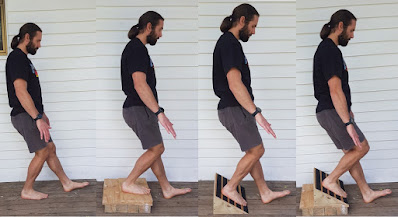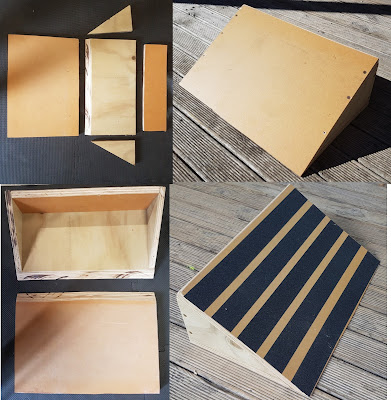 |
| 2020 was the year of the pistol squat |
I thought it would be worth writing up my current workout
plan which I have been running for roughly a year now. The main thing to
mention up front is that this program is not the optimal way of doing things.
The exercise selection, sets and reps, timing, energy systems etc, none of this
has been optimised. There is currently no periodisation. This is not my version
of a secret sauce, become batman/mega athlete program. That is all to say if
you are looking to design a program, this is not a template, only a rough
collection of ideas.
So what’s the point, why this program? The point is I
will do this program. I can, and will follow it for weeks on end, actually get
something done, and move the needle forward. This is the most important point -
the best program is the one you will do. So I’ll lay out what I’m doing and why,
as there might be some useful information here for someone looking to build
their own program to follow.
The what, how’s and why’s
The central feature of this plan was to put in a lot of
gymnastics volume, working on muscular endurance. This is something I struggle
with, and which always held me back when working on the gymnastic bodies (GB)programs. Secondary to this was to try and at least maintain some of the other movement in the GB program. I only have about 30-45 minutes max during my
prime workout time to get things done, so no there is time for extras like grip
work or conditioning (Eventually I will work this sort of thing back in, but
not yet)
So the first feature of my program - Day one is Monday.
I’ve rested during the weekend, and I’m most likely to have time and desire to
train on Monday. The things I most want to get done go here. But, if life gets
in the way for any reason, I bump this workout back to Tuesday or even
Wednesday. That way, if only one workout gets done in a week, it’s the main
workout.
Monday:
A: GB Front lever progressions (Hollow rock progression)
B1: Ring row, aiming for 5x15
B2: Push up, aiming for 5x20
B3: Shoulder dislocates, sets of 5
B4: Deadlifts 5x5 at 80kg
C: GB planche progression
A little breakdown is necessary here. It isn’t ideal to
start a workout with difficult core work, but I am terrible at these
progressions; so it’s best for me to do them first to get the work in. The push
ups and ring rows are the main muscular endurance work here and I started by
aiming for 5x10 and 5x15 respectively, adding reps where I could. I’m nearly at
a point where 5x15 and 5x20 will be my new standard. My plan is to keep this at
a maintenance point for some time, while I push more energy into the core and
planche progressions. The shoulder dislocates are a good movement to cycle in
during upper body work, I suggest applying these liberally. The deadlifts are
currently just to give me a little volume to help out my squat, and the plan is
to get to 5x5 at 100kg. I’m keeping these very light, as these are not the main
point of the workout and I don’t want them to detract for the rest of the
workout. The planche progressions are currently maintenance, but I plan on
pushing to improve these later this year. This whole workout takes me about 40
minutes, so right on the maximum amount of time that I have available.
 |
| Many, many push ups |
Tuesday
A: GB Side lever progression (Core based movement)
B1: Front squats 5x5 at 50kg
B2: Arch ups, aiming for 5x10
B3: Wrist prep sequence
The side lever progressions are another tough one for me
as its all core work, but again, putting it first and early in the week has
meant I’ve been about to make progress on it over the year. The front squats
are technique work as I’m not great at them. The plan is once I can do them at
80kg with good form to switch to overhead squats as the technique work here.
Front squats and eventually overhead squats will probably take the place of
deadlifts on Monday at some stage. The arch ups (an extreme version of a hyper
extension) are a low back exercise from gymnastic bodies which I think is
extremely valuable for lower back prep work. The plan here is to get back to
doing the twisting arch ups then maintain them (these are what I would call a
moderately advanced low back strength movement – proceed with caution). The
wrist strengthening sequence is out of the GB handstand series, google around
and you’ll find something good to follow. These are well worth including in
your program for injury prevention. This workout normally takes a little over
30 minutes, so there is room for me to add something at a later point in time.
Wednesday
Wednesdays are tricky as I have my young daughter with me
in the gym, so it needs to be something toddler safe, so this is kind of a work
in progress (I used to do Thursday’s workout here, but it just wasn’t working
out)
A1: GB handstand work
A2: Knee prep sequence
This has been the workout which most often gets dropped
out. I’m least interested in the handstand work right now, and lately my knee
has been giving me a lot of trouble making the knee movements too painful (I
have a post in the works outlining my knee trouble). For reference the knee
prep is several movements involving loading the knee in different ways, including
different twisting movements from the GB program (Have a google around if you
are interested).
Thursday
I’m really enjoying this workout which is a follow on
from my lockdown program. This is my “add one rep” workout. (I have a whole
post on this workout, so I’ll be brief here).
A1: Pistol squats
A2: Natural glute-ham curls (very big assist from the
hands)
A3: Pull ups
A4: Ring dips
I started this as 5 sets of 5 adding a rep every week;
working towards 10x5, then the final goal is 10 sets of 10. The glute-ham curls
are only 5x5 (the first 5 sets), and eventually I’ll switch them out for a full
glute-ham raise. After the 5 sets of glue-ham raise, I’ve been switching to
working on hollow rocks and arch body holds, currently its only around 3x12
(reps/sets) but the goal is to work towards 5x60. This may not be totally
possible, but putting in the work will be helpful. Each round takes just under
5 minutes, and I am currently closing in on 8x5, so approximately a 40-minute
workout. Thursday works well for this workout since it’s far enough away from
Monday/Tuesday’s strength work (In both directions), so I can push hard and get
some good work in.
 |
| Pistol squat, pull up, ring dip |
Friday
Day off, generally I’m pretty worn out by now, and I have
a lot to get done on Friday’s.
Saturday
Most of the time Saturday is a 10km road run, but
whenever possible I prefer a trail run.
 |
| Out for a training run |
Sunday
For the last little while Sunday has been 5 sets of 5
heavy back squats, currently at 120kg. The goal here is to slowly and carefully
push my max squat up. Heavy squats had been done on a Monday, but they got too
heavy with the rest of the work happening on a Monday. Not sure how long I will
keep the heavy squats here, but its working for now.
What I’m Missing.
A big thing I’m missing here is stretching, I’m trying to
get up early to get some early morning stretching down, but it’s a struggle (I
have a whole post in the works discussing AM workouts).
 |
| I need more stretching |
Also missing is BJJ, previously I was aiming for Tuesday
and Thursday, but energy levels with a new child was difficult, and 2020 was
not the year for physical contact in large groups. The plan is to get my act
together for a better 2021.
So that’s my current workout program. Hopefully there are
some useful ideas in there for you. Adapt what is useful, reject what is
useless and add what is specifically your own.










































